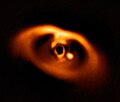
The term sub-Neptune can refer to two different types of planets. It may describe a planet that has a smaller radius than Neptune, even if that planet actually has a larger mass. [1] Alternatively, it can describe a planet with a smaller mass than Neptune, even if that planet has a larger radius (like a super-puff planet). Both definitions are sometimes used within the same scientific publication. [2]
Contents
Neptune-like planets are considerably rarer than sub-Neptune sized planets, despite being only slightly bigger. [3] [4] This "radius cliff" separates sub-Neptunes (radii < 3 Earth radii) from Neptunes (radii > 3 Earth radii). [3] This radius cliff is thought to arise because during formation when gas is accreting, the atmospheres of planets that size reach the pressures required to force the hydrogen into the magma ocean stalling radius growth. Then, once the magma ocean saturates, radius growth can continue. However, planets that have enough gas to reach saturation are much rarer, because they require much more gas. [3]
On 29 November 2023, astronomers reported the discovery of six sub-Neptune exoplanets orbiting the star HD 110067, with radii ranging from 1.94 R🜨 to 2.85 R🜨. [5] [6] [7]
